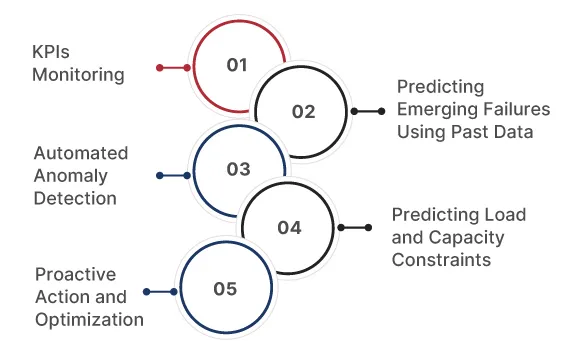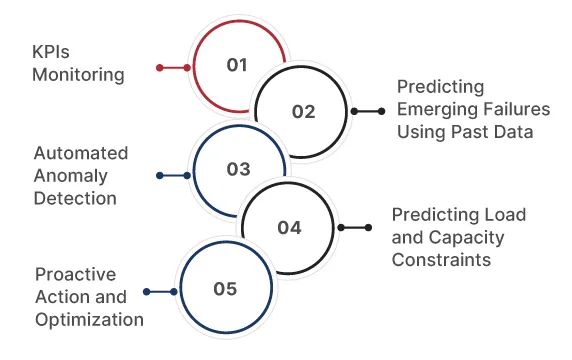Table of Contents
- What is Predictive Analytics?
- What is Performance Engineering?
- Core Activities in Performance Engineering
- Impact of Performance Bottlenecks on Business Operations
- How Predictive Analytics Identifies Performance Bottlenecks?
- How Can Tx Assist with Predictive Analytics for Performance Engineering?
- Summary
What if there’s a magic mirror at work that gives a peek into the future of a software development project? The project managers, business analysts (BA), and other stakeholders could identify potential performance bottlenecks with precision before they happen. Amazing, isn’t it? According to a study, about 95% of enterprises are using AI-powered predictive analytics to navigate their marketing strategies. Predictive analytics leverage past data to determine the possibility of specific outcomes. Businesses can improve their decision-making to better plan.
What is Predictive Analytics?
Predictive analytics is a subset of data analytics that leverages previous or historical data, ML techniques, and statistical algorithms to predict future events. Enterprises need predictive analytics to find potential bottlenecks in their application’s performance. It is often linked with data science and big data. Its key concepts include:
• Analyzing current and past data to identify patterns and trends likely to recur in the future with data-driven forecasting.
• Using statistical techniques like regression analysis, time series analysis, decision trees, etc.
• Using ML algorithms like neural networks, support vector machines, and random forests to improve prediction accuracy.
• Leveraging across industries like business, finance, healthcare, and marketing.
What is Performance Engineering?
Performance engineering is a proactive approach to software development that allows businesses to ensure their application meets performance, reliability, and scalability benchmarks. Instead of post-development testing, it’s a continuous process integrated within the software development lifecycle (SDLC). Performance engineering involves designing, implementing, and testing software to meet performance metrics like response time, throughput rate, scalability, reliability, and resource usage (CPU, disk, memory, etc.). Performance engineering delivers the following benefits:
• Improved user experience by ensuring speed and responsiveness in an application under development.
• Reduced costs by identifying and fixing performance issues early, preventing rework and delays.
• Faster software development by optimizing the development process, enabling teams to deliver applications faster.
• Improved reliability by ensuring that applications are reliable and can handle varying workloads.
Core Activities in Performance Engineering
• Performance Testing: Load testing, stress testing, and endurance testing to simulate real-world conditions.
• Profiling & Monitoring: Identifying performance hotspots in code or infrastructure.
• Optimization: Tuning code, database queries, memory usage, and network calls.
• Capacity Planning: Calculating resources required as per usage.
• Architecture Design: Selecting performance-based technologies and structures from the beginning.
Impact of Performance Bottlenecks on Business Operations
Software performance bottlenecks not only frustrate users but also impact business outcomes. They can negatively impact productivity, customer satisfaction, and costs. They also create software release delays and reduce throughput value. Decision-makers must understand that the technical slowdowns can erode revenue, brand value, and operational efficiency.
Revenue Loss:
Slow applications directly affect the bottom line, especially in transactional systems like eCommerce platforms, SaaS tools, and payment gateways. For example, a one-second delay in page load time can reduce conversion rate by 7%. For high-traffic sites, that could mean millions in lost sales annually.
Customer Frustration:
In today’s tech-driven world, user expectations have evolved. A minor lag in software performance can change a user’s perception of the product’s reliability. This could lead to users abandoning apps or switching to competitors. Bottlenecks in customer-facing systems like mobile apps, websites, and APIs can increase churn rates and reduce customer loyalty.
Reduced Productivity:
Performance bottlenecks in enterprise-grade platforms/tools can slow down teams, delay project timelines, and increase frustration. For instance, a slow CRM system or development platform can cause wasted hours, resulting in productivity loss and low morale across departments.
Poor Market Performance:
Performance is a brand asset in today’s interconnected technology landscape. Crash-prone or laggy applications can no longer fit into the market, especially in highly regulated industries like finance, logistics, or healthcare. Poor performance invites negative feedback, social media backlash, and trust issues.
Increased Costs:
Performance bottlenecks cause more escalations and emergency fixes, draining time and resources. Teams spend more time on firefighting than innovating, increasing SLA penalties and infrastructure costs.
Inaccurate Forecasting:
Bottlenecks negatively affect system behavior, making data unreliable for decision-making. This level of poor visibility causes misguided investments in infrastructure, hiring, or customer growth initiatives.
How Predictive Analytics Identifies Performance Bottlenecks?
KPIs Monitoring:
Predictive models continuously track system KPIs like CPU usage, response times, error rates, memory consumption, etc. These metrics help detect abnormal patterns indicating emerging bottlenecks. For example, a rapid increase in average response time for a microservice could mean low database query performance.
Predicting Emerging Failures Using Past Data:
Predictive models learn from past incidents to identify patterns indicating slowdowns, crashes, or breaches. These insights help the analytics team to forecast when and where such failures can repeat under comparable conditions.
Automated Anomaly Detection:
Advanced anomaly detection leverages ML algorithms to flag patterns indicating abnormal system behavior before they affect application performance. Predictive models catch subtle warning signs like latency dips, increased garbage data collection, and retry rates, common bottleneck indicators. Early alerts will enable teams to investigate and address issues before they escalate.
Predicting Load and Capacity Constraints:
Predictive analytics simulate future resource usage trends to develop infrastructure requirements. It covers load growth, user concurrency, and resource utilization, enabling businesses to identify when components will be overburdened.
Proactive Action and Optimization:
When a bottleneck is detected, the final stage is proactive action. Performance engineers use predictive insights to reallocate resources, refactor inefficient code, adjust caching strategies, schedule hotfixes, and fine-tune CI/CD workflows to improve test performance. This helps enterprises prevent failures and ensure smoother releases, and better UX.
How Can Tx Assist with Predictive Analytics for Performance Engineering?
At Tx, we leverage ML models and AI-powered data analysis to monitor trends, detect anomalies, and predict performance issues. Our approach involves continuously analyzing real-time and previous metrics to provide early warning signs and potential issues. We allow your teams to shift from reactive firefighting to strategic optimization. We leverage top-of-the-line observability and application performance monitoring tools like Prometheus, Grafana, Datadog, New Relic, and AWS CloudWatch.
Tx offers real-time alerts with its Tx-Insights dashboards, indicating performance risks (if any). Key features include:
• Customized dashboards displaying forecast trends and application health.
• Predictive alerts for security alerts, performance dips, and more.
• Visual root cause indicators to prioritize actions.
By combining predictive analytics with integration and actionable insights, Tx can become your strategic provider of performance engineering services. We can assist you in delivering resilient, high-performing applications at scale.
Summary
Predictive analytics empower performance engineering by identifying software bottlenecks before they occur. Analyzing historical and real-time system data helps teams prevent failures, optimize resources, and ensure smoother releases. Performance bottlenecks can affect user experience, business operations, and brand reputation. Tx optimizes this process by integrating predictive insights with popular monitoring tools, enabling proactive performance management through real-time alerts and intelligent dashboards. We help enterprises deliver scalable, high-performing applications with greater speed and reliability.
The post Predictive analytics in Performance Engineering: Identifying Bottlenecks Before They Happen first appeared on TestingXperts.
Source: Read More



